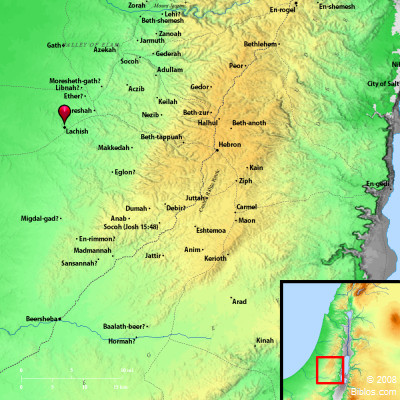Encyclopedia
LACHISHla'-kish (lakhish; Septuagint Lachis (Joshua 15:39), Maches):
1. Location:
A town in the foothills of the Shephelah on the border of the Philistine plain, belonging to Judah, and, from the mention of Eglon in connection with it, evidently in the southwestern portion of Judah's territory. Eusebius, Onomasticon locates it 7 miles from Eleutheropolis (Beit Jibrin) toward Daroma, but as the latter place is uncertain, the indication does not help in fixing the site of Lachish. The city seems to have been abandoned about 400 B.C., and this circumstance has rendered the identification of the site difficult. It was formerly fixed at Umm Lakis, from the similarity of the name and because it was in the region that the Biblical references to Lachish seem to indicate, but the mound called Tell el-Hesy is now generally accepted as the site. This was first suggested by Conder in 1877 (PEFS, 1878, 20), and the excavations carried on at the Tell by the Palestine Exploration Fund in 1890-93 confirmed his identification. Tell el-Hesy is situated on a wady, or valley, of the same name (Wady el Hesy), which runs from a point about 6 miles West of Hebron to the sea between Gaza and Askelon. It is a mound on the very edge of the wady, rising some 120 ft. above it and composed of debris to the depth of about 60 ft., in which the excavations revealed the remains of distinct cities which had been built, one upon the ruins of another. The earliest of these was evidently Amorite, and could not have been later than 1700 B.C., and was perhaps two or three centuries earlier (Bliss, Mound of Many Cities). The identification rests upon the fact that the site corresponds with the Biblical and other historical notices of Lachish, and especially upon the discovery of a cuneiform tablet in the ruins of the same character as the Tell el-Amarna Letters, and containing the name of Zimridi, who is known from these tablets to have been at one time Egyptian governor of Lachish. The tablets, which date from the latter part of the 15th or early part of the 14th century B.C., give us the earliest information in regard to Lachish, and it was then an Egyptian dependency, but it seems to have revolted and joined with other towns in an attack upon Jerusalem, which was also an Egyptian dependency. It was perhaps compelled to do so by the Khabiri who were then raiding this region. The place was, like Gaza, an important one for Egypt, being on the frontier and on the route to Jerusalem, and the importance is seen in the fact that it was taken and destroyed and rebuilt so many times.
2. History:
We first hear of it in the history of Israel when Joshua invaded the land. It was then an Amorite city, and its king, Japhia, joined the confederacy formed by Adonizedek, king of Jerusalem, to resist Joshua. They were defeated in the remarkable battle at Gibeon, and the five confederate kings were captured and put to death at Makkedah (Joshua 10 passim; Joshua 12:11). Lachish was included in the lot of Judah (15:39), and it was rebuilt, or fortified, by Rehoboam (2 Chronicles 11:5, 9). It was besieged by Sennacherib in the reign of Hezekiah and probably taken (2 Kings 18:13) when he invaded Judah and besieged Jerusalem, but the other references to the siege leave it doubtful (2 Kings 18:14, 17; 2 Kings 19:8 2 Chronicles 32:9 Isaiah 36:2; Isaiah 37:8). The Assyrian monuments, however, render it certain that the place was captured. The sculptures on the walls of Sennacherib's palace picture the storming of Lachish and the king on his throne receiving the submission of the captives (Ball, Light from the East, 190-91). This was in 701 B.C., and to this period we may assign the enigmatical reference to Lachish in Micah 1:13, "Bind the chariot to the swift steed, O inhabitant of Lachish: she was the beginning of sin to the daughter of Zion." The cause of the invasion of Sennacherib was a general revolt in Phoenicia, Palestine, and Philistia, Hezekiah joining in it and all asking Egypt for aid (Rawlinson, Five Great Monarchies of the Ancient Eastern World, chapter ix). Isaiah had warned Judah not to trust in Egypt (Isaiah 20:5, 6; Isaiah 30:1-5; 31:1), and as Lachish was the place where communication was held with Egypt, being a frontier fortress, perhaps even having an Egyptian garrison, it would be associated with the "sin" of the Egyptian alliance (HGHL, 234).
The city was evidently rebuilt after its destruction by Sennacherib, for we find Nebuchadnezzar fighting against it during his siege of Jerusalem (Jeremiah 34:7). It was doubtless destroyed by him, but we are informed by Nehemiah (11:30) that some of the returned Jews settled there after the captivity. It is very likely that they did not reoccupy the site of the ruined city, but settled as peasants in the territory, and this may account for the transference of the name to Umm Lakis, 3 or 4 miles from Tell el-Hesy, where some ruins exist, but not of a kind to suggest Lachish (Bliss, op. cit). No remains of any importance were found on the Tell indicating its occupation as a fortress or city later than that destroyed by the king of Babylon, but it was occupied in some form during the crusades, Umm Lakis being held for a time by the Hospitallers, and King Richard is said to have made it a base of operations in his war with Saladin (HGHL). The Tell itself, if occupied, was probably only the site of his camp, and it has apparently remained since that time without inhabitants, being used for agricultural purposes only.
See further, PALESTINE EXPLORATION, III, 1.
H. Porter




